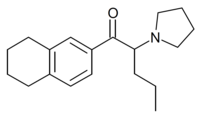TH-PVP
Appearance
 | |
| Clinical data | |
|---|---|
| ATC code |
|
| Legal status | |
| Legal status |
|
| Identifiers | |
| |
| PubChem CID | |
| ChemSpider | |
| Chemical and physical data | |
| Formula | C19H27NO |
| Molar mass | 285.431 g·mol−1 |
| 3D model (JSmol) | |
| |
| |
TH-PVP is a substituted cathinone derivative which has been sold as a designer drug. It was first identified by a forensic laboratory in Hungary in 2015,[1] but has subsequently been found in numerous other countries around the world including Spain, Belgium, Poland, Turkey and Brazil.[2][3][4][5][6][7] Pharmacological studies in vitro showed it to inhibit reuptake and promote the release of monoamine neurotransmitters with some selectivity for serotonin,[8] but it failed to produce stimulant effects in animals,[9] and has a pharmacological profile more comparable to that of sedating empathogens such as MDAI and 5-Methyl-MDA.
See also
References
- ^ EMCDDA–Europol 2015 Annual Report on the implementation of Council Decision 2005/387/JHA
- ^ Nycz JE, Pazdziorek T, Malecki G, Szala M (September 2016). "Identification and derivatization of selected cathinones by spectroscopic studies". Forensic Science International. 266: 416–426. doi:10.1016/j.forsciint.2016.06.034. PMID 27423024.
- ^ Yanini A, Esteve-Turrillas FA, de la Guardia M, Armenta S (November 2018). "Ion mobility spectrometry and high resolution mass-spectrometry as methodologies for rapid identification of the last generation of new psychoactive substances". Journal of Chromatography A. 1574: 91–100. doi:10.1016/j.chroma.2018.09.006. PMID 30220430.
- ^ Wille SM, Richeval C, Nachon-Phanithavong M, Gaulier JM, Di Fazio V, Humbert L, et al. (March 2018). "Prevalence of new psychoactive substances and prescription drugs in the Belgian driving under the influence of drugs population". Drug Testing and Analysis. 10 (3): 539–547. doi:10.1002/dta.2232. PMID 28640970.
- ^ Błażewicz A, Bednarek E, Popławska M, Olech N, Sitkowski J, Kozerski L (July 2019). "Identification and structural characterization of synthetic cathinones: N-propylcathinone, 2,4-dimethylmethcathinone, 2,4-dimethylethcathinone, 2,4-dimethyl-α-pyrrolidinopropiophenone, 4-bromo-α-pyrrolidinopropiophenone, 1-(2,3-dihydro-1H-inden-5-yl)-2-(pyrrolidin-1-yl)hexan-1-one and 2,4-dimethylisocathinone". Forensic Toxicol. 37 (2): 288–307. doi:10.1007/s11419-018-00463-w.
- ^ Göl E, Çok I (January 2019). "New psychoactive substances in Turkey: Narcotics cases assessed by the Council of Forensic Medicine between 2016 and 2017 in Ankara, Turkey". Forensic Science International. 294: 113–123. doi:10.1016/j.forsciint.2018.11.003. PMID 30502695.
- ^ Boff B, Silveira Filho J, Nonemacher K, Schroeder SD, Arbo MD (24 October 2019). "New psychoactive substances (NPS) prevalence over LSD in blotter seized in State of Santa Catarina, Brazil: a six-year retrospective study". Forensic Science International: 110002. doi:10.1016/j.forsciint.2019.110002.
- ^ Eshleman AJ, Nagarajan S, Wolfrum KM, Reed JF, Swanson TL, Nilsen A, Janowsky A (March 2019). "Structure-activity relationships of bath salt components: substituted cathinones and benzofurans at biogenic amine transporters". Psychopharmacology. 236 (3): 939–952. doi:10.1007/s00213-018-5059-5. PMC 6500773. PMID 30397775.
- ^ Gatch MB, Dolan SB, Forster MJ (June 2019). "Locomotor activity and discriminative stimulus effects of five novel synthetic cathinone analogs in mice and rats". Drug and Alcohol Dependence. 199: 50–58. doi:10.1016/j.drugalcdep.2019.02.016. PMC 6534427. PMID 30986635.
